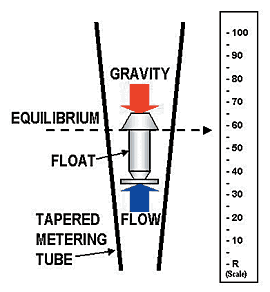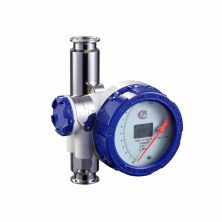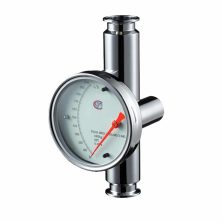Featured Products
- Standard Variable Area
- ½~10" (15-250 mm)
- Water (20 °C) (10~300000 L/h) 0.04~1320 GPM, Air (20℃, 0.1013MPa) (0.7 ~ 3.000 m3/h) 0.04~1765 SCFM
- -40-482 °F ( -40~+250 °C)
- 1.0 % Full Scale
- ½" (15mm) <30 mPa.s, 1" (25mm) 2"(50mm) <300 mPa.s
- ½" (15mm) ~ 2" (50mm) 580 psi (4Mpa), >2.½" (65mm) 232 psi (1.6MPa)
- SS# 304/316/316L and more
- 4-20mA, MODBUS, HART and alarms
- Flanges (ANSI, DN, JIS) threaded
- Liquid & compressed gasses
- Chemical lines, filtration loading, hydraulic fluids, blending applications, makeup water for food & beverage plants
- Sanitary Variable Area
- ¼~10" (8-250mm)
- Water (20 °C) (10~300000 L/h) 0.04~1320 GPM, Air (20 °C, 0.1013MPa) (0.7 ~ 3.000 m3/h) 0.04~1765 SCFM
- -40-482 °F ( -40~+250 °C)
- 1.0 % Full Scale
- ½" (15mm) <30 mPa.s, 1" (25mm) 2"(50mm) <300 mPa.s
- ½" (15mm) ~ 2" (50mm) 580PSI (4Mpa), >2½" (65mm) 232PSI (1.6Mpa)
- SS# 304/316/316L and more
- Analog, Pulse, RS232/485 MODBUS
- Sanitary / Tri-Clamp®
- Liquid & compressed gasses
-
Makeup water for food & beverage plants, brewery, pharmaceutical
- Self-Powered Variable Area
- ½~10" (15-250 mm)
- Water (20 °C) (10~300000 L/h) 0.04~1320 GPM, Air (20 °C, 0.1013 MPa) (0.7 ~ 3.000 m3/h) 0.04~1765 SCFM
- -112-752 °F ( -80~+400 °C)
- 1.5 % Full Scale
- ½" (15mm) <30 mPa.s, 1" (25mm) 2" (50mm) <300 mPa.s
- ½" (15mm) ~ 2" (50mm) 580 psi (4Mpa), >2½" (65mm) 232 psi (1.6 MPa)
- SS# 304/316/316L and more
- No Power Needed
- Flanges (ANSI, DN, JIS) threaded
- Liquid & compressed gasses
- Chemical lines, filtration loading, hydraulic fluids, blending applications, makeup water for food & beverage plants
Variable Area Flow Meter Overview
VA meters are one of the oldest-known flow measurement techniques with a large install base, and variable area meters are found in various industries where liquid and gas flows are being measured. Variable area meters all share the same basic design elements – a flow body that consists of a tapered glass or clear plastic tube or a cylindrical metal tube flow meter with an internal tapered metering pin, an internal moving float or orifice plate, and a printed scale that provides the flow rate reading.
The volumetric flow rate through the flow body is proportional to the displacement of the float. When a fluid flows through the tube from bottom to top, it causes a relatively constant pressure drop across the float, which produces an upward force that urges the float upward toward the top of the tube. Increases in flow rate are directly proportional to the square of this pressure drop.
Key Applications
Water & Energy flowmeters from SmartMeasurement have been successfully installed in a wide variety of industries and applications including:
- Water and gas flow in plants or labs
- Chemicals or additives
- Filtration loading
- Material-blending applications (i.e., lines that use a valved meter)
- Hydraulic oils
- Makeup water for food & beverage plants
- Condensate, demineralized or process water
Why Choose a Variable Area Flow Meter
Variable Area flow meters are inexpensive and easy to install and require no power as it is a purely mechanical message. Another advantage is that they are capable of measuring both liquids and compressed gasses. However, if the VA meter is making use of a gravity return to urge the float back towards the zero position rather than a spring return, then it must be installed in a vertical orientation with the flow tube perpendicular to the base. When the vertical installation is not possible, a meter having the spring return must be used. VA meters are calibrated with water for liquids and air for gasses. For applications involving fluid media other than water or air, the flow scales are corrected based on the operating density of the alternate fluid. The gases or corrosive liquids flow rates are read by aligning the top of the float with the tick mark on the flow tube. However, a change in operating parameters will compromise the meter’s accuracy, forcing it to be returned to the factory for recalibration. In general, the average accuracy of a variable-area flowmeter is ±2-4% of full-scale flow.
Special Cases
In applications where there are no power requirements, a mechanical dial is enough to offer instantaneous fluid measurement. A user can easily read the gas or liquid flow rate from either a scale next to the tube or a scale on the tube. Since power isn’t necessary, users can install the ALVAMT in hazardous and remote areas where it is expensive to supply power.
Flow measurement with Smart Measurement ALVAMT variable flowmeter is always the most common and suitable solution when it comes to measuring low flow rates of clean liquids or gases, and when economy and compact installation take priority over maximum accuracy.
Please visit our industrial measurement applications section to find more detailed information about where our Variable Area flow meters have been successfully used.
Request a quote for Variable Area flow meters for your application or contact Smart Measurement to learn more.
Advantages of Using Variable Area Flow Meters
The major advantages of SmartMeasurement’s ALVAMT variable-area flowmeter include its relatively low cost and its’ ease of installation. Its simplicity of design lends to low maintenance operation and hence, long service life. These meters also offer flexibility in different applications with a wide flow range of chemicals. With the PTFE-lined metal tube construction, variable area meters can resist corrosive damage from aggressive chemicals.
The ALVAMT variable area meter does not require power and will provide accurate flow rate readings much like a glycerin-filled pressure gauge reads pressure readings without any electrical power. This allows the meter to be deployed where it is not practical or possible to run a power cable.
Theories of Operation

A standard glass tube rotameter, or variable area flowmeter, measures the flow rate of liquids and compressed gasses by relating the position of an internal float to a corresponding flow rate on a printed scale. As the flow rate increases, pressure differential across the float also increases. This causes the float to be urged upwards toward the top of the scale. This upward motion is opposed by gravity and the mass of the float until the float reaches a point of equilibrium, at which time the float’s position my be read against the printed scale. As the float moves upwards, the area of the orifice that is formed between the float’s outside diameter and the inside diameter of the tapered tube increase – hence the term “variable area”. The increase in the orifice area that the flow travels through is proportional to the square of flow rate.
Karl Kueppers
The first variable area meter with rotating float was invented by Karl Kueppers (1874–1933) in Aachen in 1908. This is described in the German patent 215225. Felix Meyer founded the company “Deutsche Rotawerke GmbH” in Aachen recognizing the fundamental importance of this invention. They improved this invention with new shapes of the float and of the glass tube. Kueppers invented a special shape for the inside of the glass tube that realized a symmetrical flow scale.

The brand name Rotameter was registered by the British company GEC Elliot automation, Rotameter Co. In many other countries the brand name Rotameter is registered by Rota Yokogawa GmbH & Co. KG in Germany which is now owned by Yokogawa Electric Corp. Rotameters, particularly those designed for high-pressure applications or requiring non-vertical mounting orientations, are made from durable materials like stainless steel, aluminum, or brass. These metal tube variable area meters can operate under high temperatures and pressures, up to 6000 psig, making them versatile for a wide range of industrial applications.
The innovation introduced by Kueppers and subsequently refined by companies like Deutsche Rotawerke GmbH and Rota Yokogawa has had a lasting impact on flow measurement technology, with Rotameters still being a popular choice for their reliability, accuracy, and adaptability to different conditions.
What Are Metal Tube Variable Area Meters?
Metal tube variable area meters are used when the operating pressure is too high for a glass tube or when a horizontal rather than vertical mounting orientation is required. This style of variable area meter will typically feature a flow body that is machined from either stainless steel, aluminum, or brass. The position of the internal float is determined by reading the position of a needle that is mechanically coupled to the internal float or magnetically coupled follower that can be read from the outside of the tube. With this type of device, the internal float is urged back towards zero-scale by a spring rather than gravity.
The use of the stainless/aluminum/brass materials of construction for the meter’s pressure vessel allows for both high temperature operation as well as use in applications with hydraulic pressure – up to 6000 psig. The spring return allows for unlimited mounting orientations – vertical, horizontal, or diagonal with no upstream/downstream straight pipe run requirement.


